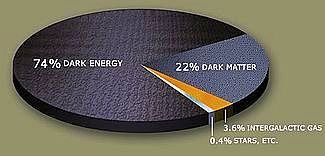In de Scientific American van april 2021 las ik een interessant artikel over “Dark Mattter detection“. Hier geef ik een samenvatting, aangevuld met nog wat extra info over dit onderwerp.
Op basis van astronomische waarnemingen weten we dat 95% van ons heelal niet bekend is, maar we hebben nog niet geïdentificeerd waaruit deze 95% bestaat. Wat we wel weten is dat ongeveer 74% is gemaakt van een mysterieuze substantie genaamd Dark Energy, en we weten ook dat er nog eens 22% is gemaakt van zogenaamde Dark Matter.
Als deze donkere materie zou zijn gemaakt van bekende deeltjes, dan hadden we die materie al lang geleden waargenomen. Omdat we dat niet hebben gedaan, is het vermoeden dat donkere materie is gemaakt van een nieuw soort deeltje dat tot nu toe is ontsnapt aan detectie door deeltjesversnellers.

Detectie van donkere materie
Terwijl je deze tekst leest, stromen er letterlijk miljarden van deze donkere materiedeeltjes door je lichaam. En het is verleidelijk om te proberen deze deeltjes te vangen met een natuurkundig experiment. Het detecteren van een deeltje donkere materie zou de volgende sensatie in de natuurkunde zijn, na de ontdekking van het Higgs-deeltje in 2012 en de eerste detectie van een zwaartekrachtgolf in 2015.
In de jaren negentig begonnen experimenten met het proberen te detecteren van de deeltjes waaruit donkere materie bestaat. Sindsdien hebben natuurkundigen steeds meer bewijs gevonden dat donkere materie echt is, maar geen enkel teken van het spul zelf. Hoewel wetenschappers graag zeggen dat negatieve resultaten net zo belangrijk zijn als positieve resultaten, beginnen onderzoekers ongeduldig te worden, nu ze na tientallen jaren nog niets hebben gevonden.
Een nieuwe versie van het langlopende XENON-experiment dat eind vorig jaar (2020) van start ging, wil dat patroon eindelijk doorbreken.

Donkere Mateerie deeltjes zijn WIMPs?
Een van de beste gissingen van natuurkundigen over de identiteit van donkere materie is dat het is gemaakt van deeltjes die WIMPs worden genoemd – zwak op elkaar inwerkende, massieve deeltjes. Deze elementaire stukjes materie hebben een massa ergens tussen die van het proton en 1000 keer de massa van het proton, en ze zouden alleen met gewone atomen interacties hebben door zwaartekracht en de zwakke kernkracht, die radioactiviteit regelt. De aantrekkingskracht van WIMPs komt voort uit het feit dat ze goed passen bij supersymmetrie – een theorie die suggereert dat elk bekend deeltje een zwaardere tegenhanger heeft.
Maar door de jaren heen, toen experiment na experiment niets opleverde, is een deel van het enthousiasme voor de WIMPs vervaagd.

“Je begint je hoofd te krabben en denkt dat dat misschien het verkeerde paard was om op te wedden“, zegt Rafael Lang, een natuurkundige aan de Purdue University, die al meer dan 20 jaar aan het XENON-experiment in het Gran Sasso National Laboratory in Italië werkt. Voor nu zegt Lang echter dat hij zijn geld op WIMPs houdt, erop wijzend dat experimenten veel van de theorieën hebben ontkracht die voorspellen hoe WIMPs eruit zouden kunnen zien. “Als je 10 jaar geleden in WIMPs geloofde, is slechts de helft van die WIMPs nu uitgesloten“, zegt hij. “De andere helft leeft nog.”
Het nieuwste XENON-experiment
De nieuwste versie van het XENON-experiment, XENONnT, was in maart 2020 in aanbouw. Ondanks de problemen die door COVID-19 werden veroorzaakt, kon het project de bouw afronden en halverwege 2020 doorgaan naar de inbedrijfstellingsfase. Het doel is om donkere deeltjes te vangen in de zeer, zeer zeldzame gevallen waarin ze gewone atomen tegenkomen.
De gebruikte atomen zijn in dit geval xenon (vandaar de naam van het experiment). Het xenon wordt in vloeibare vorm bewaard in een gigantisch vat begraven onder anderhalve kilometer rots om het te beschermen tegen kosmische straling en andere vormen van vervuiling.
Xenon, met zijn 54 protonen en elektronen en nog meer neutronen, is een goed, dicht doelwit voor Donkere Materie om tegenaan te botsen. Als een exotisch deeltje een xenon-kern zou raken, zou het de kern of een elektron door de vloeistof kunnen laten vliegen, waardoor een lichtflits ontstaat die foto-multiplicatoren op de boven- en onderkant van het vat kunnen detecteren.
Deze nieuwste iteratie van het experiment bevat vier keer meer xenon dan de vorige versie, wat betekent dat er vier keer meer kans is om een signaal te zien.
Betere detectiesystemen
Andere upgrades zijn onder meer een verbeterde zuivering van het xenon en betere systemen om kosmische straling te detecteren en hoeveelheden radioactieve elementen in het experiment op te sporen. Want die kunnen zich voordoen als signalen van donkere materie. “Elke bout en moer op de detector is met de hand gemaakt van zorgvuldig geselecteerde materialen“, zegt Lang, “want als je gewoon een roestvrijstalen bout koopt bij de bouwmarkt, is die te radioactief voor wat we nodig hebben.”
Voor de buitenwereld lijken deze jaren van noeste arbeid zonder beloning misschien teleurstellend, zelfs belachelijk, maar natuurkundigen zien dat anders. “Als je afgaat op het feit of er donkere materie is gedetecteerd, dan hebben ze dat niet gedaan, maar in de ogen van de gemeenschap is het een dramatisch succesvol experiment“, zegt theoretisch natuurkundige Dorota Grabowska van CERN, die geen deel uitmaakt van het project. Het succes, zegt ze, ligt in de vele mogelijkheden die het heeft uitgesloten en de steeds grotere gevoeligheden die het heeft bereikt. Ten slotte kan het experiment WIMPs zelfs in zijn geheel als een mogelijkheid uitsluiten.
De Xenon-samenwerking wordt momenteel (2021) geleid door de Italiaanse natuurkundige Elena Aprile van Columbia University.
In Nederland is de onderzoeksgroep Donkere Materie, gehuisvest bij Nikhef in Amsterdam, onder leiding van prof.dr.ir. Colijn lid van de XENON-samenwerking.
Nieuwe manieren van detectie
“Er is veel opwinding en creativiteit rond het identificeren van nieuwe manieren om kandidaten voor donkere materie te detecteren“, zegt theoretisch natuurkundige Tongyan Lin van de Universiteit van Californië in San Diego. Een idee waar ze aan werkt, is het gebruik van kristallen om donkere deeltjes op te vangen. In kristalvorm kunnen elementen zoals silicium een interactie met donkere materie registreren bij lagere energieën dan traditionele detectoren, waardoor een nieuwe mogelijkheid voor ontdekking ontstaat.
Star Trek
Hoewel Donkere Materie ongrijpbaarder is gebleken dan sommigen aanvankelijk hadden gehoopt, geven natuurkundigen nog lang niet op.
“Veel mensen hebben een kijk op wetenschap die lijkt op Star Trek“, zegt theoretisch natuurkundige Tim Tait van de University of California. “Je ziet iets, schakelt een tricorder in en krijgt antwoord. Maar het is eigenlijk een heel rommelig proces en je probeert veel dingen totdat je iets vindt dat werkt. Alle dingen die niet werkten waren een belangrijk onderdeel van het proces.”
Wordt vervolgd.



